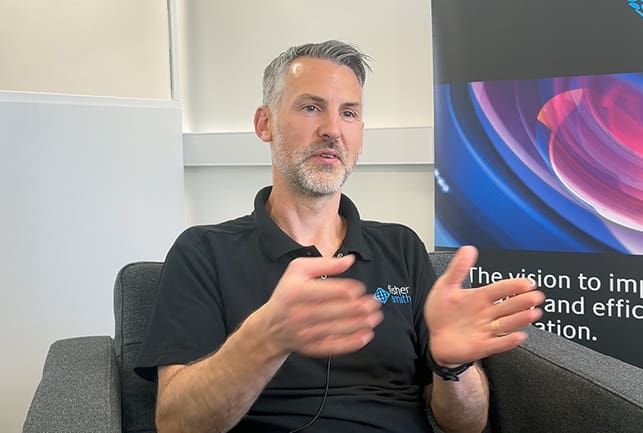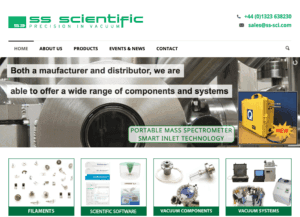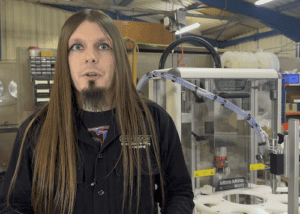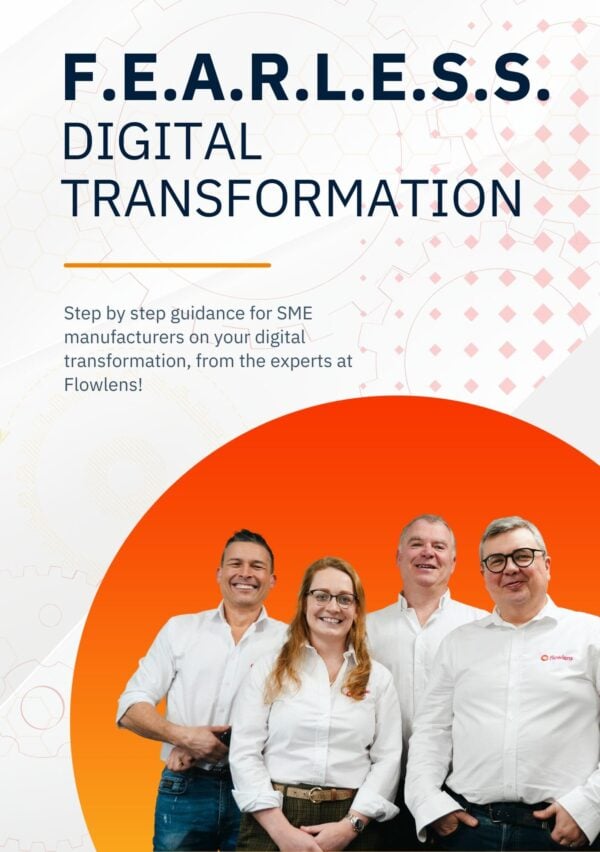Fisher Smith, a leading provider of bespoke machine vision systems for industrial automation based in Corby, UK, faced a common challenge among growing specialised businesses: disparate systems and a lack of centralised information. This fragmentation hindered operational efficiency, created inconsistencies, and limited the company’s ability to scale effectively. This case study explores how Fisher Smith, through a strategic shift in their approach to business systems, achieved significant operational benefits, streamlined workflows, and positioned themselves for sustained growth.
The Operational Imperative: Why Fisher Smith Sought a Solution
For years, Fisher Smith, under the guidance of Managing Director Iain Smith, operated with a blend of conventional tools. While their expertise in machine vision integration was undeniable, their internal processes were less sophisticated. Quotes were generated in accounting software (Sage), customer communications were managed through Outlook, and records were scattered across various platforms. This created significant operational hurdles:
- Data Silos: Information about customers, sales interactions, and project details resided in separate, unconnected systems. This led to a lack of a unified customer view and made it difficult to track the complete lifecycle of a project.
- Inconsistent Processes: Without a single, integrated system, workflows were often ad-hoc and inconsistent. This created opportunities for errors, missed steps, and a lack of standardised procedures.
- Limited Visibility: It was challenging to gain a comprehensive overview of sales pipeline, project progress, or resource allocation. This lack of visibility hampered decision-making and proactive management.
- Inefficient Quoting and Order Conversion: The process of converting a quote into a sales order involved jumping between multiple applications, leading to potential delays and administrative overhead.
- Poor Record Keeping: Critical data, such as time spent on projects or service interactions, was often recorded sporadically or on disconnected spreadsheets, making analysis and accountability difficult.
Iain Smith emphasised the motivating factor for seeking a change:
“Our colleague at the time had got a much larger experience with big corporations. And our mantra is very much we need to present ourselves and do what large corporations would do. If we think how big businesses think, we’ll generally be doing the right things in the right way, and process and structure will follow really.”
This philosophy underscored the need for a robust, integrated system that could support Fisher Smith’s ambitions for structured growth and professional presentation.
The Journey to a Unified System: Learning from Past Attempts
Fisher Smith’s journey to an effective system wasn’t without its detours. Their initial attempts to centralise operations highlighted crucial lessons:
- Early CRM Challenges: The first foray into a CRM solution, while a step in the right direction for customer record keeping, failed to integrate with their quotation system. This perpetuated the data silos they were trying to overcome.
- The “Too Big” System: A subsequent attempt with a Microsoft solution, recommended by a consultant, proved to be overly complex and required significant upfront investment to tailor it to their specific needs. This led to a lack of user adoption and ultimately, failure. Iain Smith noted: “It was really such a complicated system. It needed to have thousands of pounds spent on it to focus it to work for our business, and we never made that investment up front… there was no adoption of it, that was the main issue.”
These experiences solidified Fisher Smith’s understanding that a successful solution needed to be more than just powerful; it had to be the right fit – integrated, user-friendly, and tailored to their specific business processes.
Flowlens: A Tailored Solution for Integrated Operations
The search for a truly integrated solution led Fisher Smith to Flowlens MRP and CRM software. The key requirement was a system that could seamlessly combine CRM, quotation management, product kitting, and project tracking. A critical component was also the ability to integrate with their accounting platform. This led to a parallel decision to migrate their accounting to Xero, which offered native integration with Flowlens.
Iain Smith described the pivotal decision:
“We started speaking with Flowlens at that point and it felt like the fit was quite close at that point, but we wanted to make sure that we didn’t lose the link to the accountancy that we also valued. So in the process, we changed accountancy to work with Xero as well, that connects with Flowlens in the background.”
This strategic move laid the foundation for a truly unified operational environment.
Unlocking Operational Benefits: The Impact of Flowlens
The implementation of Flowlens brought about a transformative shift in Fisher Smith’s day-to-day operations, delivering a multitude of direct and indirect benefits:
Streamlined Workflows and Enhanced Consistency
- Single Source of Truth: Flowlens became the central repository for all critical business information, from customer records and sales opportunities to project milestones and bills of materials. This eliminated data silos and provided a unified view of every interaction.
- Seamless Process Flow: The entire sales and project lifecycle, from initial quote to sales order conversion, project initiation, and technical execution, now occurs within a single, interconnected system. This replaced fragmented manual processes with a smooth, automated workflow.
- Reduced Gaps and Errors: By enforcing a set process and making all steps visible and logically linked, Flowlens significantly reduced the risk of omissions or errors that were previously common with disparate systems. “Whether it directly saves us time, what it probably saves us, which is the intangible thing, is the consistency that we get out of that. Because it’s going through a set process and that’s all visible and the steps are logical and they’re linked, we’re not falling into gaps with it.”
Improved Visibility and Decision-Making
- Real-time Project Tracking: Key milestones, time spent, and bill of materials are all tracked within Flowlens, providing real-time insights into project progress and resource utilisation.
- Enhanced Service Management: The system allows for easy tracking of active service contracts, enabling proactive engagement with customers and improved service delivery.
- Empowered Information Access: The ability to query data within Flowlens empowers employees to quickly find information they need, such as delivery timelines, outstanding purchase orders, or project profitability. “The thing is to go and look in Flowlens and make sure we record our interactions with customers at whatever point, because if it’s a service interaction, sales can go in and see that they’ve spoken to that customer as well… it’s just linked it all together, so it’s been great.”
Boosted Accountability and Compliance
- Accurate Time Tracking: The integrated timesheet functionality, a previous weakness, became significantly more reliable and easier to use. This provides precise data on time spent on projects and service calls. “We’ve definitely become better at doing that because it’s just easier and it’s built into the system.”
- Profitability Analysis: With accurate time and material tracking, Fisher Smith can now reliably assess the profitability of individual jobs, enabling more informed pricing and operational adjustments. “It certainly allowed us to reliably check that we’re profitable on all the jobs and see which ones we are and aren’t in. So it’s given us more capability to analyse it rather than thinking, ‘we didn’t record enough on that project, so we don’t really know’.”
- ISO Accreditation Support: Flowlens aids in meeting ISO 9001 accreditation requirements by providing a structured way to record and surface critical interactions and events, ensuring full traceability. “A lot of the things that we need to tick to get that accreditation is just a question of adding another interaction in Flowlens, just making sure we record this thing has happened at this point in time and we’ve got that timed and dated and recorded somewhere and we can easily surface that.”
Unexpected Benefits and Future Growth
- R&D Tax Credit Claims: The improved record-keeping of project time, particularly for internal development initiatives, has significantly simplified the process of making R&D tax credit claims. “Just having a project in the background where we know thing, it’s not a customer’s project, it’s something we’re doing, but we’ve got somewhere where we can easily… just log the time… and it’s all kept and easy to access and makes those claims much simpler.”
- Foundation for Scalability: As Fisher Smith anticipates continued steady growth, Flowlens provides the essential process and structure to support new team members and expand operations without sacrificing efficiency. The system ensures that checks and balances are in place, even as the team grows and roles evolve. “Any sort of growth we go forward, really process and structure, becomes quite a critical part of that. And that’s what we’ve got with Flowlens as well, is that we can start to hang our processes on that and we follow these things, we do these things, we have the checks and balances to make sure that we don’t drop the ball anywhere where people are maybe new to doing different aspects of the work or if we’re bringing new engineers on, then they’ve got a structure to work within.”
The Implementation Experience: A Smooth Transition
Fisher Smith’s experience with Flowlens implementation was notably positive, largely due to a structured onboarding process and a focused internal approach. The key aspects included:
- Defined Project Plan: The transition was guided by a clear and well-structured project plan, allowing Fisher Smith to track their progress at every stage.
- Internal Champion Model: A designated internal expert was trained on Flowlens, who then disseminated the information internally, tailoring the training to specific roles. This approach fostered internal adoption and reduced reliance on external support for routine queries.
- Stress-Testing During Trial: A critical factor in successful adoption was Fisher Smith’s thorough “abuse” of the Flowlens trial period. They actively populated the trial environment with their own products and ran their processes through it, identifying potential showstoppers before full commitment. “We did really abuse the trial service that we got with Flowlens for that month or maybe even slightly longer that we had the trial environment to use. We tried to get everyone to use it and really stress tested it.”
Conclusion: A Single Touch Point for a Smarter Business
For Fisher Smith, Flowlens has become far more than just another software package; it is the operational backbone of their business. The transition to a unified system has delivered tangible benefits in terms of efficiency, consistency, visibility, and accountability. By providing a single, accessible touch point for all day-to-day operations, Flowlens has empowered Fisher Smith to work smarter, support their growth ambitions, and ensure the ongoing success of their specialised machine vision integration services.
Iain Smith sums up the impact succinctly:
“It gives us a single touch point that everyone’s using for day to day business. All the business runs through Flowlens, and everyone’s touching it. Everything is visible and linked and traceable.”
This shift has not only optimised their current operations but also established a robust framework for future expansion, allowing Fisher Smith to continue its trajectory of steady and sustainable growth.





